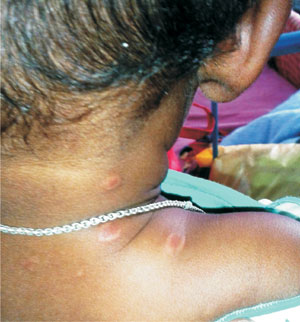A 10-month-old girl presented with erythematous pruritic
rash on cheeks, ears and trunk along with swelling of the
feet for last 12 hours (Fig. 1a). She
had a fever with coryza for two days and received three
doses of paracetamol. Rashes were discrete, round,
blanchable, and a few were ‘target lesions’ (Fig.
1b). There was no evidence of mucosal
involvement, arthritis or involvement of any other system.
Complete blood count, erythrocyte sedimentation rate and
C-reactive protein were normal. A diagnosis of urticaria
multiforme was made and she was treated with hydroxyzine and
ranitidine. The rashes gradually disappeared in next 4 days.
 |
 |
| (a) |
(b) |
|
Fig.1 Erythematous rash on
cheeks, ears and trunk.
|
Urticaria multiforme, a form of acute
annular urticaria, is a benign, self-limiting cutaneous
hyper-sensitivity reaction mediated by histamine. It is
characterized by the acute and transient onset of blanchable,
arcuate, annular, polycyclic, erythematous wheals and facial
or acral edema. It usually occurs in children between 4
months and 4 years. Viral illness, immunization and drugs
like antibiotics or paracetamol could be the inciting
factors. Erythema multiforme, urticarial vasculitis (both
having fixed lesions, dusky, purpuric centers often with
necrosis and blistering which resolve slowly over weeks with
post inflammatory depigmentation; and mucosal erosions); and
serum sickness (high grade fever, myalgia, arthralgia,
lymphadenopathy and frequent neutropenia in addition to skin
and mucosal involvement) are important differential
diagnoses.

